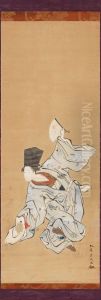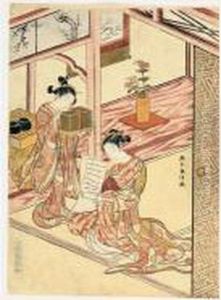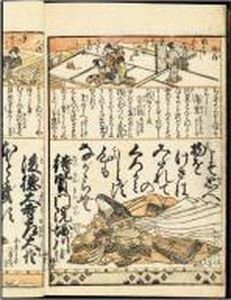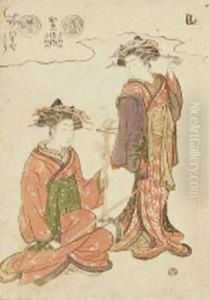Kitao Shigemasa Paintings
Kitao Shigemasa was a Japanese ukiyo-e artist known for his prints and illustrated books. Born in Edo (present-day Tokyo), Shigemasa is regarded as one of the prominent figures of the ukiyo-e movement during the middle Edo period. The term 'ukiyo-e' translates to 'pictures of the floating world' and refers to a genre of Japanese art that flourished from the 17th to the 19th century, which depicted the hedonistic lifestyle of the time, including scenes of kabuki actors, sumo wrestlers, courtesans, and landscapes.
Shigemasa began his artistic career as a pupil of Nishimura Shigenaga, who was another distinguished ukiyo-e artist. Shigemasa's early works reflected the influence of his master, particularly in the delicate and graceful lines that would become a distinguishing feature of his own style. He worked on a variety of subjects, but he was particularly adept at creating bijinga (images of beautiful women). His representations of women were noted for their elegance and realism, often capturing contemporary fashions and the beauty of the everyday woman of Edo.
In addition to single-sheet prints, Kitao Shigemasa was also a prolific book illustrator. He contributed to the popularization of 'ehon,' or picture books, which combined images with narratives or poetry. These books covered a wide range of subjects, from the instructional to the erotic (shunga), and were accessible to a broader audience than single prints due to their lower price point.
Shigemasa also collaborated with other artists, most notably Kitao Masayoshi, also known as Kuwagata Keisai, and together they produced some of the period's most admired illustrated books. One of Shigemasa’s notable works is the 'Hyakunin isshu uba ga etoki' (The Hundred Poems Explained by the Nurse), a series of prints illustrating classical Japanese poetry which he produced with the poet and artist Santo Kyoden.
Over time, Shigemasa's style evolved, reflecting changes in the broader ukiyo-e genre. He was known for experimenting with Western shading techniques and perspective, which were being introduced into Japan at that time. This incorporation of Western artistic elements was part of a larger trend in ukiyo-e known as 'Rangaku,' or Dutch learning, which emerged as Japan slowly began to end its period of national isolation.
Shigemasa's works continue to be celebrated for their beauty and historical value. His prints provide a window into the culture and fashion of the Edo period, and his books remain important examples of early Japanese printing. Kitao Shigemasa passed away in 1820, leaving behind a legacy that would influence future generations of Japanese artists.



